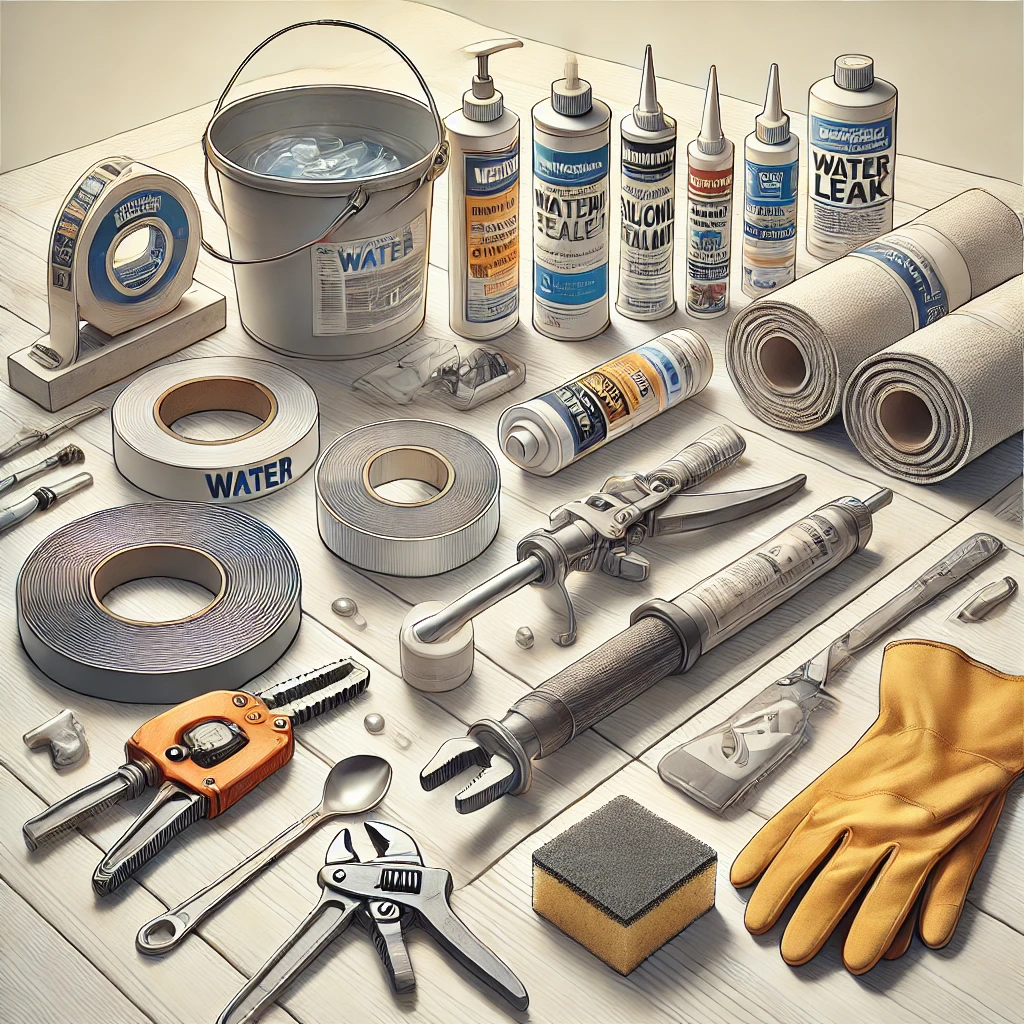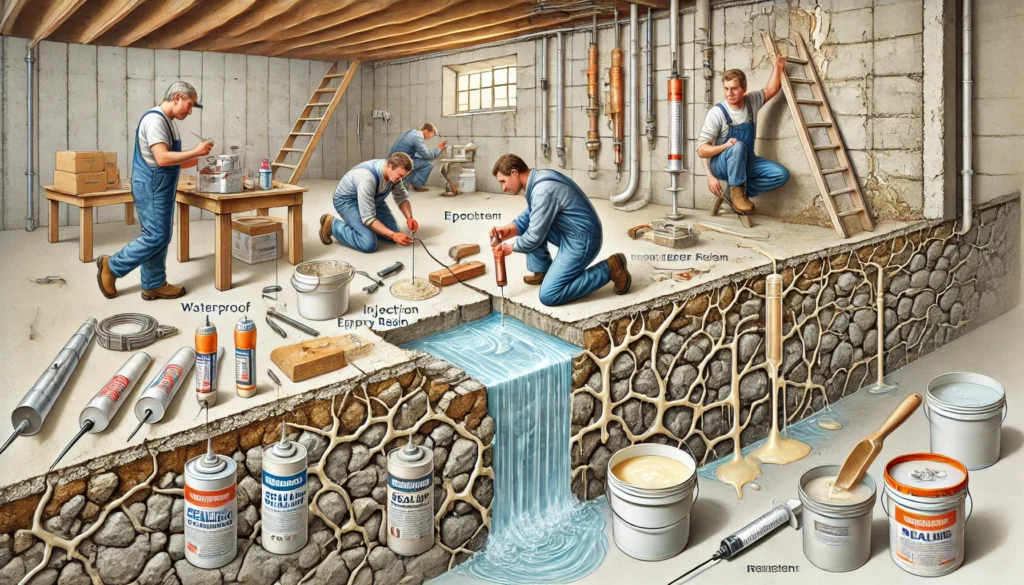Basement leakages- generally an issue for many homeowners across the country. Drenching one’s basement can lead to several issues, including mold growth, structural damage, and health hazard. When water leaks, it’s time to repair it, as it is vital for the well-being of the house and the family.
Why Address a Water Leak in Wall Basement?
Such leaks create an environment for mold growth and threaten the structural integrity of your home. Therefore, a serious health hazard for allergic and asthma sufferers.
Long exposure could even weaken the foundation of your house, which might call for repairs that you don’t want to pay later. Damage costly as it can discourage if walls seep from basement floors, but continue doing the right thing by not allowing water to pool around the foundation.
Tracing Water into the Basement Walls
The most common causes of water leaking from basement walls.
A basement wall will usually leak due to some of the following common causes-poor drainage, cracks in the foundation walls, rotten or blocked plumbing, and inadequate waterproofing. Finding the exact cause of the water leak is important to implement a proper solution and avoid any further complications.
Signs that Can Help Identify the Source of the Leak
Some of the regular signs indicating water leakage in basement walls include damp patches or discoloration, mold growth, musty smells, peeling ceilings or wallpaper, and efflorescence (a white, chalky residue). Monitoring your basement for those signs should let you catch them early enough to prevent further destruction caused by the water leaks.
Detecting Entry Points for Water
There are many tools that can help you detect entry points for water into basement walls: moisture meters, infrared camera, and dye test. They are tools used to show how water penetrates or accumulates within the basement wall.
Preparing for the Repair
Safety Precautions to Consider
Before attempting to repair a water leak in your basement wall, it is essential to take safety precautions to protect yourself from potential hazards. Wear protective gear such as gloves, safety goggles, and a mask to prevent exposure to mold or harmful chemicals. Ensure good ventilation in the area to avoid respiratory issues.
Materials and Tools Needed for Sealing a Water Leak

Depending on the severity of the water leak, you may need materials such as sealant, waterproofing paint or membrane, epoxy injection kits, drainage systems, and tools like brushes, rollers, caulking guns, and sump pumps. Make sure to gather all the necessary supplies before starting the repair process.
Preparing the Area for Repair
Clear the area around the water leak by removing any furniture, belongings, or obstacles that may hinder the repair process. Thoroughly clean the wall surface to ensure proper adhesion of the sealing materials. Use a brush or vacuum to remove dust, debris, and any traces of mold or mildew.
Methods for Sealing a Water Leak in a Basement Wall

Injection of Sealant
One common method for sealing water leaks in basement walls is the injection of sealant into cracks or gaps where water is entering. This method is effective for repairing minor leaks and preventing water intrusion. Epoxy injection kits are readily available and easy to use for DIY repairs.
Application of Waterproofing Paint or Membrane
Applying waterproofing paint or membrane on the interior or exterior surface of the basement wall can help create a barrier against water penetration. Waterproofing products come in various forms such as liquid coatings, sealants, and membranes, providing flexibility in choosing the right solution for your needs.
Installation of a Drainage System
In cases where water infiltration is persistent or severe, installing a drainage system like a French drain or sump pump can effectively redirect water away from your basement walls. A drainage system helps manage water buildup around your foundation and prevents leaks from occurring.
Step-by-Step Guide for Sealing the Water Leak
Clearing the Area Around the Leak
Begin by clearing the area around the water leak and ensuring that it is clean and dry. Remove any obstacles, debris, or mold growth that may impede the repair process. Take precautions to protect nearby surfaces and belongings from damage during the repair.
Applying the Chosen Sealing Method
Follow the manufacturer’s instructions for the selected sealing method, whether it involves injecting sealant, applying waterproofing paint, or installing a drainage system. Use appropriate tools and techniques to ensure a proper seal and effective protection against water leaks.
Allowing Time for the Sealant to Cure
After completing the sealing process, allow sufficient time for the sealant to cure and form a strong bond with the wall surface. Avoid exposing the repaired area to water or moisture until the sealant has fully set to ensure long-lasting results. Monitor the repaired area for any signs of water intrusion or damage.
Additional Tips for Preventing Future Water Leaks
Proper Maintenance of Gutters and Downspouts
Regularly clean and inspect your gutters and downspouts to ensure proper drainage of rainwater away from your home. Clogged or damaged gutters can lead to water pooling near your foundation and causing leaks in your basement walls. Maintain good gutter health to prevent water infiltration.
Ensuring Proper Grading Around the Foundation
Check the grading around your home’s foundation to ensure that water flows away from the building and does not accumulate near the basement walls. Proper sloping of the land can help divert water away from your home and reduce the risk of water leaks and foundation damage.
Regular Inspections for Early Detection of Leaks
Schedule routine inspections of your basement walls, foundation, and plumbing system to detect any signs of water leaks or damage early on. Prompt action can prevent minor issues from escalating into major problems and save you time and money on extensive repairs.
Conclusion
Recap of Key Points
Addressing water leaks in basement walls is essential to protect your home from structural damage, mold growth, and health hazards. By identifying the source of the leak, preparing for the repair, and sealing the water leak effectively, you can maintain a safe and dry living environment for you and your family.
Importance of Acting Promptly
Acting promptly to seal water leaks in basement walls can help prevent costly repairs and health issues associated with water damage and mold growth. By taking proactive measures and addressing water leaks early on, you can safeguard your home and ensure its longevity.
Encouragement for DIY Repairs and Seeking Professional Help
While DIY repairs can be a cost-effective solution for minor water leaks, it is important to seek professional help for complex or extensive issues. Professional contractors have the expertise and equipment to address severe water leaks and ensure long-lasting results. Don’t hesitate to contact a professional if you are unsure about how to proceed with the repair.
FAQs (Frequently Asked Questions)
1. Can I use waterproofing paint to seal a water leak in my basement wall?
Yes, waterproofing paint can be an effective way to seal minor water leaks in basement walls. It creates a barrier against water intrusion and helps protect the wall surface from moisture damage. However, for more severe leaks or persistent issues, additional sealing methods may be needed.
2. How do I know if the water leak in my basement wall is due to a plumbing issue?
If you suspect that the water leak in your basement wall is caused by a plumbing issue, check for signs of moisture or water near plumbing fixtures, such as pipes, water heaters, or washing machines. A professional plumber can inspect the area and determine the source of the leak.
3. Is it safe to seal a water leak in my basement wall myself?
Sealing a water leak in your basement wall can be safe if you take proper precautions and follow manufacturer instructions for the sealing method. Ensure good ventilation, wear protective gear, and use appropriate tools to minimize risks. If you are unsure or dealing with a complex issue, consider seeking professional help.
4. How long does it take for sealant to cure on a basement wall?
The curing time for sealant on a basement wall can vary depending on the type of sealant used and environmental conditions. It is recommended to allow at least 24 to 48 hours for the sealant to fully cure and form a strong bond with the wall surface. Avoid exposing the area to water during this curing period.
5. What should I do if the water leak in my basement wall persists after sealing?
If the water leak in your basement wall persists after sealing, it may indicate a more extensive issue that requires professional attention. Contact a waterproofing specialist or contractor to assess the situation and determine the appropriate solution for effectively stopping the water intrusion.
6. Can improper grading around my home’s foundation cause water leaks in the basement walls?
Yes, improper grading around your home’s foundation can contribute to water leaks in the basement walls. If the ground slopes towards your home, water can collect near the foundation and seep into the basement walls. Correcting the grading to ensure proper drainage away from the building can help prevent water infiltration.
7. Are there any DIY methods for installing a drainage system to prevent water leaks in basement walls?
While some homeowners may attempt to install a simple drainage system like a French drain themselves, it is recommended to consult a professional for more complex drainage solutions. Improper installation of a drainage system can lead to further problems and may not effectively prevent water leaks in basement walls.
8. How often should I inspect my basement walls for water leaks?
It is advisable to inspect your basement walls for water leaks regularly, at least once every few months. Keep an eye out for signs of moisture, mold, musty odors, or peeling paint, as these may indicate water intrusion. Early detection of leaks can help prevent significant damage and costly repairs.
9. What are the benefits of hiring a professional to seal water leaks in basement walls?
Hiring a professional to seal water leaks in basement walls can ensure that the issue is addressed effectively and efficiently. Professionals have the expertise, tools, and experience to identify the source of the leak and apply the appropriate sealing method. They can also provide long-term solutions to prevent future water leaks.
10. How can I prevent mold growth in my basement walls after sealing a water leak?
To prevent mold growth in your basement walls after sealing a water leak, ensure proper ventilation, control humidity levels, and address any existing moisture issues. Consider using a dehumidifier, repairing leaks promptly, and maintaining good airflow in the basement to discourage mold growth. Regular inspections can help detect early signs of mold and prevent it from spreading.

